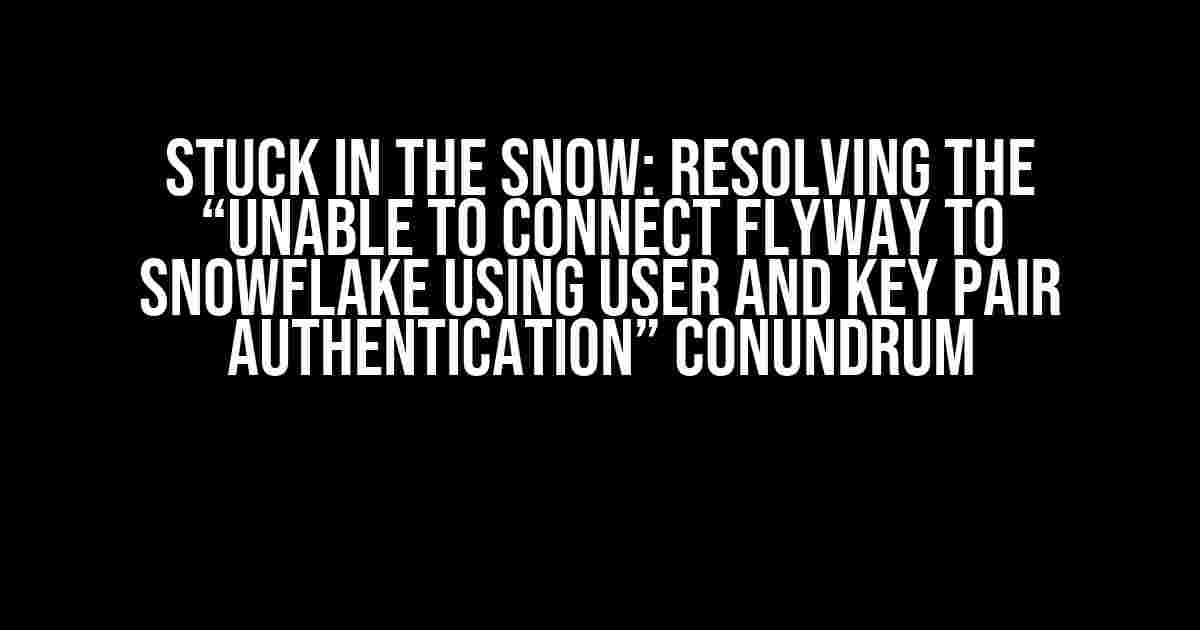Flyway and Snowflake, a match made in heaven, right? Unfortunately, the honeymoon phase can quickly turn into a frustrating battle when you’re stuck trying to connect the two using user and key pair authentication. Don’t worry, you’re not alone! In this comprehensive guide, we’ll walk you through the most common pitfalls and provide clear, step-by-step instructions to help you overcome the “unable to connect” hurdle and get your database migration workflow up and running smoothly.
The Basics: Flyway and Snowflake 101
Before we dive into the nitty-gritty, let’s quickly cover the basics:
- Flyway: A popular, open-source database migration tool that helps you version and manage changes to your database schema.
- Snowflake: A cloud-based, columnar storage data warehousing platform designed for high-performance analytics and reporting.
- User and Key Pair Authentication: A secure method for authenticating with Snowflake using a username and private key pair, rather than a password.
Troubleshooting: Common Issues and Solutions
So, what’s going wrong? Let’s explore some common issues and their solutions:
Issue 1: Incorrect or Missing Configuration
Flyway relies on a configuration file (flyway.conf) to connect to your Snowflake instance. Make sure you’ve got the following properties set correctly:
flyway.url=jdbc:snowflake://account_name.snowflakecomputing.com
flyway.user=YOUR_USERNAME
flyway.password=filesb://${HOME}/.ssh/YOUR_PRIVATE_KEY
flyway.driver=net.snowflake.client.jdbc.SnowflakeDriver
Remember to replace:
- `account_name` with your actual Snowflake account name.
- `YOUR_USERNAME` with your Snowflake username.
- `YOUR_PRIVATE_KEY` with the path to your private key file.
Issue 2: Private Key File Format
Snowflake requires a PEM-formatted private key. If you generated your key pair using OpenSSL, you might need to convert the private key to PEM format:
openssl rsa -in private_key.pem -out private_key.pem
Double-check that your private key file has the correct format:
-----BEGIN RSA PRIVATE KEY-----
...
-----END RSA PRIVATE KEY-----
Issue 3: Permissions and Access Control
Verify that your Snowflake user has the necessary permissions to access the database and perform the required actions:
- Make sure the user has the `ACCOUNT_ADMIN` role or equivalent.
- Grant the `CREATE DATABASE` and `CREATE SCHEMA` privileges on the desired database.
Issue 4: Flyway Driver Version
Ensure you’re using a compatible version of the Snowflake JDBC driver:
<dependency>
<groupId>net.snowflake</groupId>
<artifactId>snowflake-jdbc</artifactId>
<version>3.13.16</version>
</dependency>
Update your Flyway configuration to use the correct driver version.
Step-by-Step Guide to Connecting Flyway to Snowflake using User and Key Pair Authentication
Now that we’ve addressed the common issues, let’s walk through the setup process from scratch:
Step 1: Generate a Key Pair
Use OpenSSL to generate a private and public key pair:
openssl genrsa -out rsa_key 2048
openssl rsa -pubout -in rsa_key -out rsa_key.pub
Step 2: Create a Snowflake User and Grant Permissions
Create a new Snowflake user and grant the necessary permissions:
CREATE USER flyway_user
IDENTIFIED BY PASSWORD = '***'
DEFAULT_ROLE = 'ACCOUNT_ADMIN'
DEFAULT_WAREHOUSE = 'COMPUTE_WH';
GRANT CREATE DATABASE TO ROLE flyway_user;
GRANT CREATE SCHEMA TO ROLE flyway_user;
Step 3: Configure Flyway
Create a `flyway.conf` file with the following contents:
flyway.url=jdbc:snowflake://account_name.snowflakecomputing.com
flyway.user=flyway_user
flyway.password=filesb:///${HOME}/.ssh/rsa_key
flyway.driver=net.snowflake.client.jdbc.SnowflakeDriver
Step 4: Initialize Flyway
Initialize Flyway with the configuration file:
flyway -configFile=flyway.conf init
Step 5: Verify the Connection
Run a simple Flyway command to verify the connection:
flyway -configFile=flyway.conf info
If everything is set up correctly, you should see a successful connection message.
Conclusion
With these steps and troubleshooting tips, you should be able to overcome the “unable to connect” hurdle and successfully integrate Flyway with Snowflake using user and key pair authentication. Remember to double-check your configuration, key pair format, and permissions to ensure a smooth database migration workflow.
Happy migrating!
| Keyword | Description |
|---|---|
| Flyway | A popular, open-source database migration tool. |
| Snowflake | A cloud-based, columnar storage data warehousing platform. |
| User and Key Pair Authentication | A secure method for authenticating with Snowflake using a username and private key pair. |
Need further assistance or have questions about this article? Feel free to reach out in the comments below!
Frequently Asked Question
Stuck on connecting Flyway to Snowflake using user and key pair authentication? Worry not! Here are some answers to get you flying high again!
Why do I get an “Authentication failed” error when using user and key pair authentication with Flyway and Snowflake?
Check that you’ve generated the correct private key file in PEM format, and that the key pair is correctly configured in Snowflake. Also, ensure that the correct username and account details are provided in the Flyway configuration.
How do I specify the private key file in Flyway configuration for Snowflake authentication?
In your Flyway configuration file, add the following properties: `snowflake.private.key.file` and `snowflake.private.key.passphrase`. For example: `snowflake.private.key.filepath=/path/to/private/key` and `snowflake.private.key.passphrase=your_passphrase`.
Can I use aSnowflake account with a custom domain instead of the standard snowflakecomputing.com domain?
Yes! When using a custom domain, you need to specify the correct URL in the Flyway configuration. For example: `jdbc:snowflake://your_custom_domain.com:443/`. Make sure to update the URL accordingly.
What are the minimum Snowflake permissions required for Flyway to connect and perform migrations?
Flyway requires the `ACCOUNTADMIN` or `SECURITYADMIN` role to connect and perform migrations. Ensure the user has the necessary permissions to create and manage objects in Snowflake.
How do I troubleshoot issues with Flyway and Snowflake user and key pair authentication?
Enable Flyway’s debug logging to get more detailed error messages. Check the Flyway logs for any errors or warnings related to authentication. Also, verify that the private key file and passphrase are correct, and that the Snowflake account is configured correctly.
